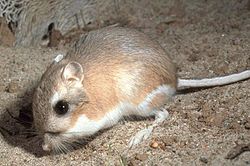Dipodomyinae
| Dipodomyinae Temporal range: Late Miocene – Recent |
|
|---|---|
 |
|
| Kangaroo rat | |
| Scientific classification | |
| Kingdom: | Animalia |
| Phylum: | Chordata |
| Class: | Mammalia |
| Order: | Rodentia |
| Family: | Geomyoidea |
| Family: | Heteromyidae |
| Subfamily: |
Dipodomyinae Gervais, 1853 |
| Genera | |
Dipodomyinae is a subfamily of heteromyid rodents, the kangaroo rats and mice. Dipodomyines, as implied by both their common and scientific names, are bipedal; they also jump exceptionally well. Kangaroo rats and mice are native to desert and semidesert ecosystems of western North America from southern Canada to central Mexico. They are generally herbivorous foragers, and dig and live in burrows.
Dipodomyinae is the sister group of a Perognathinae-Heteromyinae clade; the two are estimated to have split about 22-24 million years (Ma) ago. The most recent common ancestor of extant dipodomyines is thought to have lived 15-16 Ma ago, when the two genera split. The most recent common ancestors of extant members of Dipodomys and Microdipodops are thought to have lived 10-11 and 7-8 Ma ago, respectively.
...
Wikipedia
